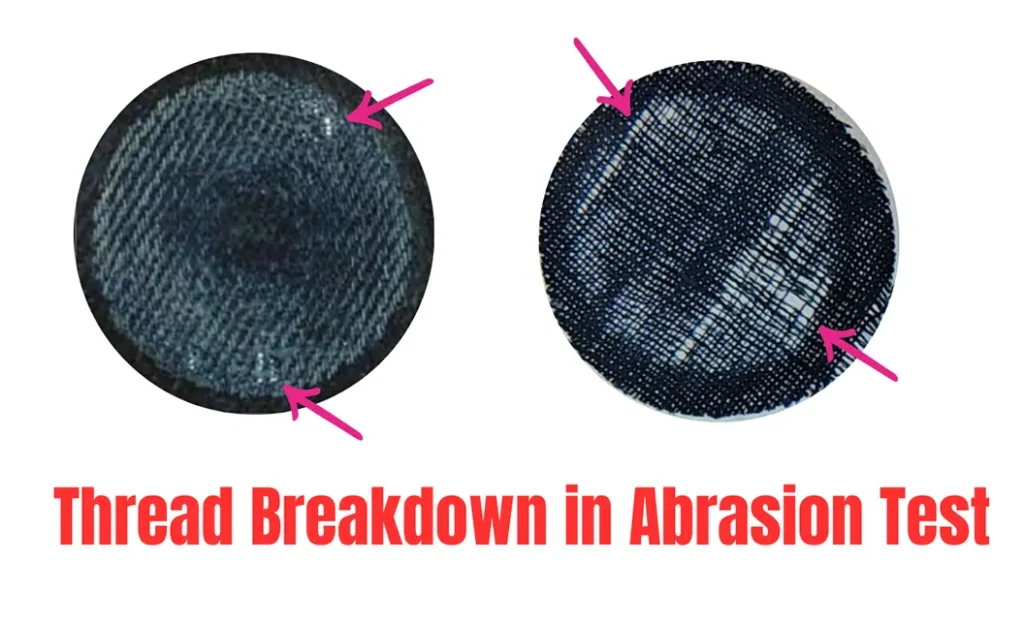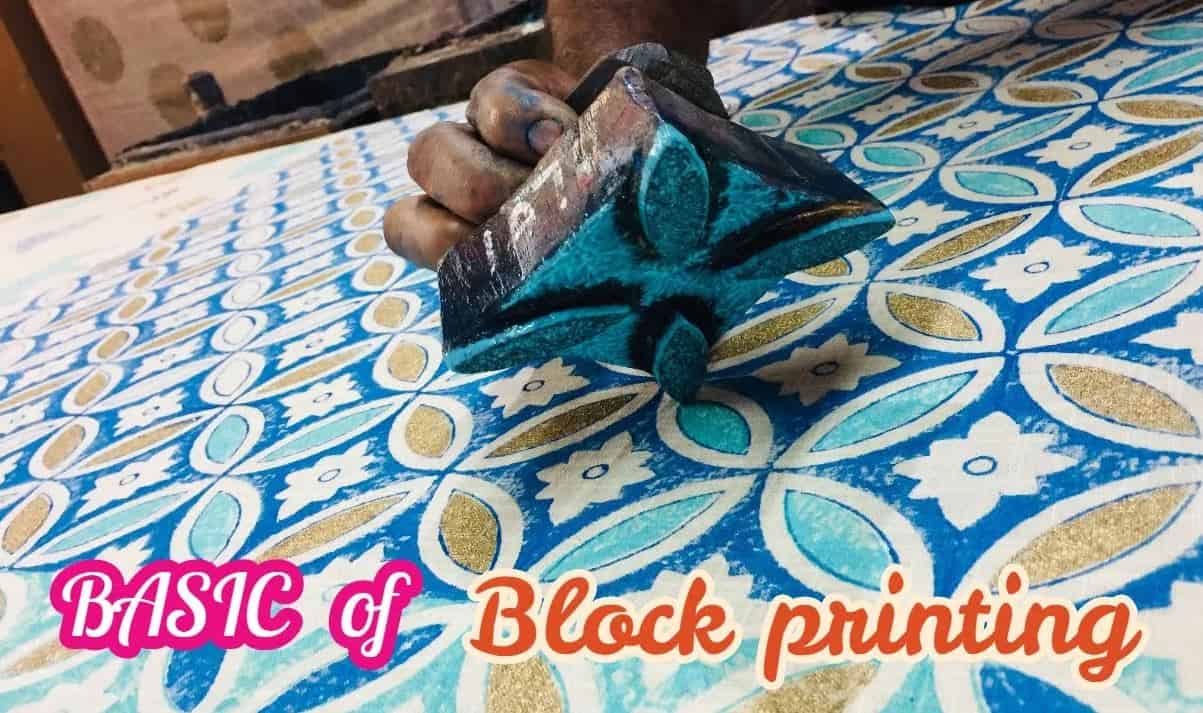Fabric Abrasion:
Fabric abrasion refers to the wearing away of any part of the fabric by friction with another surface. Throughout their lifespan, fabrics undergo abrasion, which can lead to wear, degradation, damage, and a decline in performance. However, the capacity to withstand abrasion is just one of several aspects that influence the overall wear performance and durability of the fabric.
Fabric abrasion, is crucial context of textiles, is the process of surface damage caused by repeated rubbing or scraping against another surface.

Classification of Fabric Abrasion:
We can classify abrasion as follows-
1. Fabric Plane or flat abrasion:
Abrade a flat area of fabric.
2. Fabric Edge abrasion:
For example, the kind of abrasion which occurs at collars and folds.
3. Fabric Flex abrasion:
In this case, the fabric flexes and bends while it is rubbed.
Factors Affecting Fabric Abrasion resistance:
1. Fiber type:
♦ High elongation, elastic recovery, and work of rupture are believed to be more significant criteria for achieving a good level of abrasion resistance in a fiber compared to high strength.
♦ People widely regard nylon as having superior abrasion resistance. Similarly, both polyester and polypropylene are known for their excellent abrasion resistance.
♦ Wool, cotton, and high wet modulus viscose exhibit a moderate level of resistance to abrasion. In contrast, viscose and acetates have the least resistance to abrasion.
2. Fiber properties:
♦ One consequence of abrasion is the progressive erosion of fibers from the yarns. Hence, any factors that impact the cohesiveness of yarns will also have an effect on their ability to withstand abrasion.
♦ Longer fibers enhance the abrasion resistance of a fabric more effectively than shorter fibers because they are more difficult to extract from the yarn.
♦ Filament yarns outperform staple yarns in abrasion resistance due to their longer fibers, enhancing durability.
3. Yarn twist:
♦ In order to obtain the highest level of resistance to wearing away, a yarn must possess an ideal quantity of twist. Increased twist levels enhance the fibers ability to retain their shape, but this also results in a stronger yarn that resists flattening or distorting when subjected to pressure during abrasion.
♦ At low-twist factors, the fibers can be readily detached from the yarn, resulting in a steady decrease in diameter.
4. Fabric structure:
♦ Fabrics with evenly distributed crimp between warp and weft threads offer optimal durability, distributing damage uniformly. Yarns exposed on the surface wear the most.
♦ An optimal fabric set value exists for achieving the highest level of abrasion resistance. As the thread count per centimeter increases in a fabric, the individual threads experience reduced force.
Method of Assessment:
- Two approaches have been employed to evaluate the impacts of abrasion.
- Use abrasion to wear down the sample until reaching a preset end-point, such as creating a hole. Record the time or number of cycles it takes to reach this end-point.
- Abrade for set time or number of cycles and assess some aspect of the abrade fabric such as change in appearance, loss of mass, change in thickness or other relevant property.
- Appearance against an unabraded specimen.
- Loss in strength, e.g. tensile, bursting and tearing strength.
- Change in other properties such as air permeability, luster etc.
- Examination of yarns and fibers for microscopic damage.
Instrument of Abrasion Resistance Measurement:
- Martindale abrasion tester
- WIRA abrasion tester
- Taber Abraser
- Schiefer Uniform Abrasion Tester
- Wyzenbeek Abrasion Tester
- Universal Wear Tester (UWT)
Martindale abrasion testing method:
The Martindale method of abrasion testing, governed by ISO 12947-(1&2) is a standardized procedure used to assess the durability and resistance to abrasion and pilling of textile fabrics.
Apparatus and Consumables:
- Martindale abrasion testing machine.
- Magnifier for examining the specimens in test, minimum of 8X.
- Sample cutter.
- Grey Scale for assessing shade change.
- Wool abradant fabric cut into pieces at least 140mm in diameter.
- Woven Wool Felt, cut into pieces 140.0 – 140.5mm in diameter.
- Polyurethane backing foam , cut into pieces 38.0 – 38.5mm diameter.

sample preparation:
- The fabric should be conditioned in a relaxed state for at least 18 hours.
- Maintain controlled room conditions of 20 +/- 2°C room temperature.
- Maintain controlled room conditions of 65 +/ – 2% of relative humidity.
- Cut four specimens, ensuring a diameter of 38.0 – 38.5mm, with the face of the fabric kept uppermost.

Machine setup for Martindale abrasion testing:
- Lift the top plate away from the abrading tables.
- Remove the abradant clamping rings.
- Place a piece of felt on each abrading table, followed by a piece of abradant over the felt.
- Place the press weight on top and secure with the clamping ring.
- Finally, replace the top plate.
- Once the machine is set up, it’s time to mount the specimens.
- Place the base of the specimen holder into the mounting device on the machine frame.
- Then, place the test specimen face down into the base of the holder.
- For samples with a mass per unit area of less than 500 g/m, place a circle of foam onto the test specimen.
- Secure the specimen/foam in place with the specimen holder insert and screw down tightly.
- After mounting the test specimens, place the specimen holders and spindles in their designated work stations accurately.
- Finally, based on either the fabric weight or specific buyer requirements, place the 9 kPa or 12 kPa auxiliary weight a top of the spindles.
- This ensures proper testing conditions.
Testing procedure in Martindale abrasion tester:
- Set the machine counter to a preset number of rubs as per the specification.
- Start the machine and wait until the preset number of rubs is reached.
- Then, examine each specimen for signs of breakdown using the magnifier.
- Ensure you inspect the fabric continually after specific rub as per method, to check for wear and tear.
- Immediately you notice any change in the appearance of the fabric, or when two yarns break, you end the test immediately.

Breakdown Point ( End-Point):
- For woven fabrics, two separate threads are completely broken.
- For knitted fabrics, one thread is completely broken causing a hole to appear.
- For pile fabrics, pile is completely worn away.
- For nonwoven fabrics, first hole to appear is of a diameter of at least 0.5mm.

results in Martindale abrasion tester:
The test report should include information such as the mass and nominal pressure used, the number of rubs at which breakdown occurred for each specimen, and the mean result. If a breakdown did not occur, report the result as greater than the number of rubs at which the test was stopped. Additionally, report any pills removed from the specimens and the test intervals at which this was done.
Inspection Intervals for Martindale Abrasion Test:
| Estimated number of cycles | Intervals for inspection |
| Up to 5,000 | Every 1,000 |
| Between 5,000 and 20,000 | Every 2,000 |
| Between 20,000 and 40,000 | Every 5,000 |
| Above 40,000 | Every 10,000 |

Average rate of loss in mass:
- This is an alternative method of assessing abrasion resistance which requires eight specimens for the test.
- Two of these are abraded to the end point as described above and then the other pairs are abraded to the intermediate stages of 25%,50% and 75% of the end point.
- The samples are weighed to the nearest 1mg before and after abrasion so that a graph can be plotted of weight loss against the number of rubs.
- From the slope of this graph, if it is a straight line, the average loss in mass measured in mg/1000 rubs can e determined.
Factors affecting Fabric abrasion test:
1. Type of abrasion:
This may be plane, flex or edge abrasion or a combination of more than one of these factors.
2. Type of abradant:
A number of different abradants have been used in abrasion test including standard fabrics, steel plates and abrasive paper or stones. The severity as well as the type of action is different in each case.
3. Pressure:
The pressure between the abradant and the sample affects the severity and rate at which abrasion occurs. It has been shown that using different pressure can seriously alter the ranking of a set of fabrics when using a particular abradant.
4. Speed:
Increasing the speed of rubbing above that found in everyday use also brings the dangers of accelerated testing as described above. A rise in temperature of the sample can occur with high rubbing speeds, this can affect the physical properties of thermoplastic fibers.
5. Tension:
It is important that the tension of the mounted specimen is reproducible as this determines the degree of mobility of the sample under the applied abradant. This includes the compressibility of any backing foam or inflated diaphragm.
6. Direction of abrasion:
In many fabrics the abrasion resistance in the warp direction differs from that of the weft direction. Ideally the rubbing motion used by an abrasion machine should be such as to eliminate directional effects.
References:
- Principles of Textile Testing by J E Booth.
- Handbook of Textile Testing and Quality Control by E. B. Grover, Elliot Brown Grover, Dame Scott Hamby.
- Martindale abrasion tester
To learn more on Laboratory testing and accreditation you can check on the following article:















4 thoughts on “Fabric Abrasion Resistance: Martindale Abrasion Testing Process”
excellent sir❤️
Thanks for the compliment.
Very excellent content, Thanks sir
Thanks for the compliment.